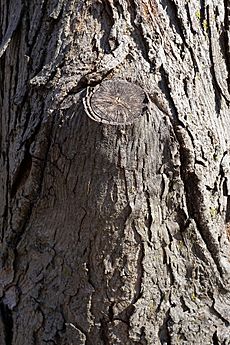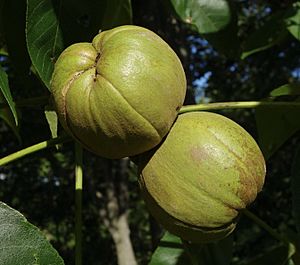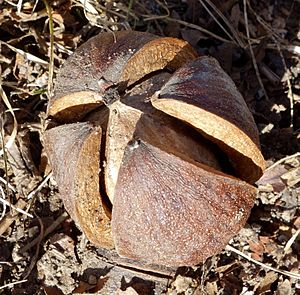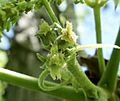Shellbark hickory facts for kids
Quick facts for kids Shellbark hickory |
|
|---|---|
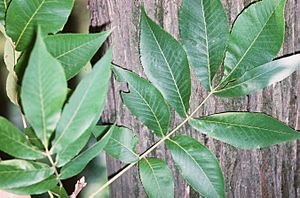 |
|
| Leaves and bark | |
| Conservation status | |
| Scientific classification | |
| Genus: |
Carya
|
| Species: |
laciniosa
|
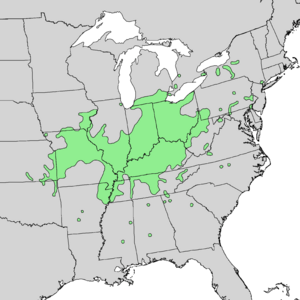 |
|
| Natural range | |
The shellbark hickory (Carya laciniosa) is a large tree in the Juglandaceae family, also known as the walnut family. People call it by many names like shagbark hickory, kingnut, or bigleaf shagbark hickory. These names often describe its features. It grows slowly and lives a long time. It's hard to move once planted because it has a very long main root that goes deep into the ground.
The nuts from this tree are the biggest of all hickory nuts. They are sweet and good to eat! Many animals, and people too, enjoy these nuts. The wood of the shellbark hickory is very strong, heavy, and flexible. This makes it great for things like tool handles. Some very tall shellbark hickory trees have been found. One in Missouri was about 117 centimeters (46 inches) wide and 36.9 meters (121 feet) tall.
Contents
Where the Shellbark Hickory Lives
Native Home
Shellbark hickory trees grow across a wide area in North America. You can find them from western New York, through Michigan and Iowa, down to Oklahoma, and east to Pennsylvania. They are most common near the Ohio River and along the Mississippi River. You might also spot them in the big river swamps of Missouri and Indiana.
Sadly, these trees are not as common as they used to be. This is partly because people have cleared forests and cut down trees for wood. The heavy seeds don't travel far from the parent tree. Also, people don't plant them much in gardens because they grow slowly and are hard to move.
Climate Needs
Shellbark hickory trees grow in places where the weather is just right. The time without frost usually lasts from 150 to 210 days. In January, the average temperature is between -4 and 5 degrees Celsius (25 to 41 degrees Fahrenheit). In July, it's usually between 23 and 27 degrees Celsius (73 to 81 degrees Fahrenheit).
The coldest it gets in the northern areas is about -26 degrees Celsius (-15 degrees Fahrenheit). The hottest it gets anywhere in its range is about 38 degrees Celsius (100 degrees Fahrenheit). These trees need a good amount of rain, usually between 750 and 1500 millimeters (30 to 59 inches) each year. This includes some snow.
Soil and Land
Shellbark hickory trees grow best in deep, rich, and moist soils. They don't do well in heavy clay but love loamy or silty soils. They need more moisture than some other hickory types. You can often find them on riverbanks and floodplains. They do well in areas that might be covered by shallow water for a few weeks in spring. However, they can grow in many different types of land.
Forest Friends
Shellbark hickory trees are often found alone or in small groups mixed with other hardwood trees. They are a small part of forests that include trees like bur oak, pin oak, and swamp chestnut oak.
They commonly grow with American elm, slippery elm, white ash, green ash, basswood, red maple, blackgum, sweetgum, and cottonwood. You can also find them with other hickory trees like shagbark, mockernut, bitternut, and water hickory. Many types of oak trees also grow nearby, such as swamp white oak, pin oak, white oak, and swamp chestnut oak.
Smaller plants and shrubs that grow with shellbark hickory include painted buckeye, pawpaw, flowering dogwood, eastern redbud, possumhaw, poison ivy, and trumpet-creeper.
Life Cycle and Growth
How They Grow
Hickory trees, including the shellbark hickory, grow slowly. Young trees grow about 2 millimeters (0.08 inches) wider each year. Older trees can grow up to 5 millimeters (0.2 inches) wider annually. Shellbark hickory trees can sometimes reach heights of 40 meters (130 feet) and be 100 centimeters (39 inches) wide.
Roots
Shellbark hickory trees have a large, deep main root called a taproot. Other roots spread out sideways from the taproot. These side roots usually grow about 30 centimeters (12 inches) or more below the ground. In Illinois, their roots grow fast in spring, slow down in summer, speed up again in September, and stop growing in late November.
Young trees form special partnerships with fungi in the soil. This helps the trees get nutrients.
Dealing with Other Plants
Shellbark hickory trees are very good at growing in the shade. Only sugar maple and beech trees can handle more shade. However, shellbark hickories still grow slowly if there is a lot of shade. They do well and reproduce when there is only some shade. They are strong competitors against other plants around them.
In forests, shellbark hickory trees often have a clear trunk for about half their height. Their tops are narrow and oval-shaped. Trees that grow in open areas have egg-shaped tops.
Pests and Diseases
While many insects and diseases can affect hickory trees, none seriously threaten the shellbark hickory as a whole. However, some insects can greatly reduce the number of nuts produced. Two main ones are the pecan weevil and the hickory shuckworm.
The hickory bark beetle can damage or even kill trees by feeding under the bark. The larvae of the hickory spiral borer can also harm young trees. The flatheaded appletree borer's larvae feed on the tree's inner bark and wood.
Other insects, like the living-hickory borer, feed in the trunks and branches. A twig girdler can kill the tops of young trees. Many wood-boring insects attack dead trees and cut logs.
Many insects eat the leaves of hickory trees. While they don't cause major problems, they can sometimes make the tree grow a bit strangely or slow its growth.
Shellbark hickory trees are generally free of serious diseases. But they can host over 130 types of fungi. These fungi can cause leaf diseases, stem cankers, and wood or root rot.
Fire can hurt the trunk of a shellbark hickory, and these injuries often lead to wood rot. The trees are strong against snow and ice but can be damaged by frost.
Uses of the Shellbark Hickory
The nuts of the shellbark hickory are edible and a favorite food for many animals. Ducks, quail, wild turkeys, squirrels, chipmunks, deer, foxes, raccoons, and mice all enjoy them. Some farms have even been started just to grow shellbark hickory nuts. The nuts are a bit hard to crack, but the kernels inside are very sweet.
The wood from these trees is used for many things. It's made into furniture, tool handles, sports equipment, and drumsticks. It's also used for veneer (thin layers of wood), fuelwood, and charcoal.
Genetics
Shellbark hickory trees can mix with other types of hickory trees. They can cross with the pecan tree (creating a hybrid called Carya x nussbaumeri). They can also cross with the shagbark hickory (making Carya x dunbarii).
Shellbark hickory trees have 32 chromosomes. Generally, hickory species with the same number of chromosomes can cross with each other. Many mixed types (hybrids) have been found among hickory species that have 32 chromosomes, such as pecan, bitternut, shellbark, and shagbark hickories.
Gallery



